The full-stack content partner for leading SaaS brands



That’s what the “marketing” in “content marketing” means. Every piece of content must contribute to users, leads, revenue, and other critical business objectives.



Every team member is here to learn, become exceptional at their craft, and help our clients achieve results. Our mission is to transform our people into the best in the business.
The organic content marketing agency trusted by scaleups


















Scaling SaaS content engines since 2016
Within our first year in business, our clients quickly realized that the quality of our content was far too good to create exclusively for other brands.
Not only that, but our expertise in growth marketing, content, and SEO over a decade of working with B2B and SaaS brands was being kept under wraps.



































































































Blog posts

Done right, you can build an engaged audience of loyal fans and customers. The trick is to:
- Post valuable content consistently—both single tweets and threads
- Interact with your audience in the comments, rather than scheduling posts and walking away
This strategy will help you build an audience and brand awareness at speed while attracting new leads and users who have problems you can solve.
Here’s why investing in your Twitter presence is effective for growth and lead generation, and how to write content that generates reach, engagement, and leads.
Why Twitter is an audience and revenue-generating machine
When you build a community around your brand (both business and personal), your credibility compounds and improves your brand equity because people see you as a human rather than a faceless entity.
This awareness helps you attract fans that are eager to pay attention to what you have to say because your content resonates with them.
As you consistently provide helpful content, you’ll build authority and credibility—just like you would from any other content marketing channel.
The key is to stop thinking of Twitter as a repurposing platform and start thinking about it as a channel to create original content. It’s a content platform with its own ecosystem and search engine. It’s more than a digital billboard for your latest article, event, or announcement—a mindset that severely undermines its potential for attracting your audience.
You wouldn’t post a blog that says “We wrote a new thread on quality content so go check it out on Twitter” with a link. Yet, that’s exactly what some businesses use Twitter to do. This strategy doesn’t work because it’s outdated, cumbersome, and neglects how people want to digest information on the platform.
Users want content served to them directly on the platforms they’re logged into. Non-native content disrupts the intended user experience and breaks a pattern. Unless given a compelling reason to click away, they want platform-specific content.
Amanda Natividad, VP of Marketing at SparkToro, coined the term zero-click content to describe that, now more than ever, people crave in-platform content without needing to interrupt their consumption habits.
SparkToro’s data (as well as our own) show that platforms and algorithms favor in-platform content:

It’s obvious why algorithms prefer it; they want to keep people on their platforms.
But people also expressly favor high-quality native content because it allows them to:
- Engage with brands where they already are (clicking away can feel cumbersome)
- Experience non-intrusive messaging (CTAs and external links can feel out of place)
- Actually read what’s put in front of them (links are often overlooked or not read)
On that last point, the data is fascinating. A study from Columbia University found that 59% of social media links shared by news domains aren’t clicked on at all.
Furthermore, HubSpot looked at 2.7 million link-containing tweets and found that there is no correlation between retweets and clicks. This means that people will retweet something without even reading it, which aligns with the Columbia findings.
The data makes our jobs as marketers seem bleak, but that's only true if you treat Twitter like a place to simply distribute content. When you tack a link onto the tail end of platform-specific content it will only drive traffic if:
- You’ve spent time sharing native content without links and built an engaged audience on the platform
- You do it sparingly (the 80/20 rule is a good true north for articles)
Not all links are created equal, so the 80/20 rule doesn’t always apply. A link to a blog post is different from a link to a newsletter signup form, for example. The former requires a decent time commitment while the latter is a quick action.
As such, newsletter CTAs or forms can be tacked onto most posts, preferably a few hours after you share them. This works to:
- Bring your post to the top of people’s feeds again (additional tweets in a thread can trigger the algorithm to ‘reshare’ it)
- Provide a key window of time for native-only content to be consumed
For example, I created native content almost exclusively in my first four months on Twitter and grew my audience from ~500 to ~14k.
Because of this, by the time I promoted an article, people were eager to not only click but spend time reading it. In 24 hours, we generated::
- 233 pageviews
- 214 unique pageviews
- 4:48 average time on page
My goal was to build my credibility to a point where people believed me when I said “read this: it's worth your time.” This experiment proved successful and my links now generate clicks, leads, and new clients.
Both threads and single tweets are critical to growth
Single tweets are important and should be incorporated into your content strategy. But love them or hate them, threads tend to have a bigger reach (and impact).
Use threads to expand organic reach
Check out the difference in impressions between a single tweet of mine vs. a thread with only 100 more likes (the higher the like count, the less impactful differences of hundreds become):
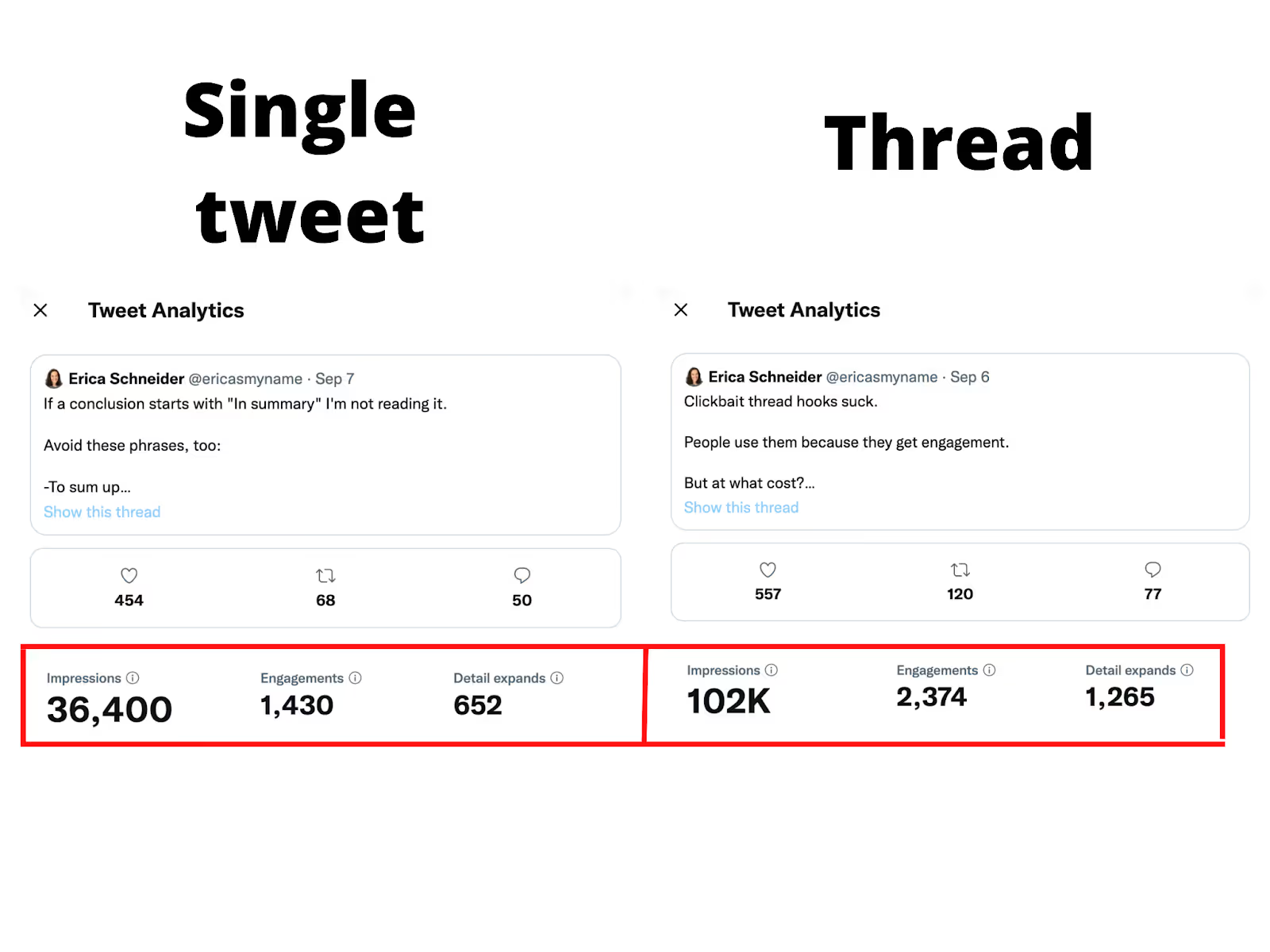
These were posted one day apart, which means I was reaching a similar audience.
While the thread only got 100 more likes, it received ~65,000 more impressions, was shared ~2x more times, and got ~2x more engagement.
Threads generally perform better because they’re educational in nature and help people solve problems. Whether you’re teaching people how to do something or telling a story of success or failure, your audience is learning as they read and taking notes on how to apply the tips to their own circumstances.
Because of this, your audience will likely be more engaged and keen to retweet and share with their network. Twitter rewards engagement (i.e. comments and retweets), meaning reach compounds.
Think of threads like long-form articles for Twitter, written with a blend of copywriting and content writing styles.
Let’s return to the thread I mentioned earlier that linked to our Quality Content Marketing Matters article at the end and break down why it was successful.
Here are the analytics:
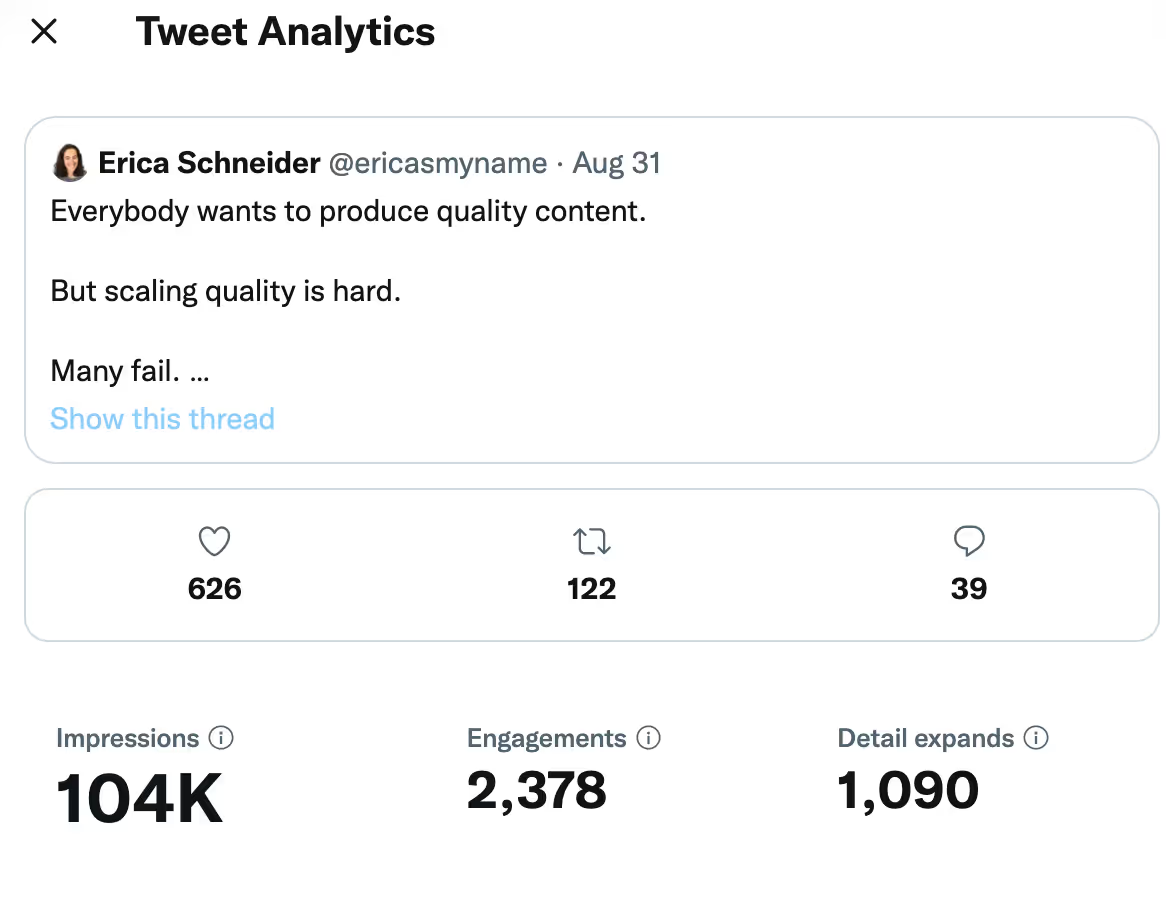
Over 100k impressions and 2k+ engagements is a great result and led directly to that spike in pageviews and time on page referenced above.
I repromoted the same article a few days later in a single tweet with a link and it got 100+ likes but generated nearly 100K fewer impressions than the thread:

The thread drove more engagement, and more readers to my article, generated several leads, and expanded my personal (and subsequently Grizzle’s) brand awareness.
Use single tweets to bolster engagement and show your personality
As for single tweet formats, quick tips, pieces of expertise, or questions to your audience can drum up tons of engagement even if the reach isn’t always as impressive.
For example, this single tweet asking a question about writing and editing sitting vs. standing got ~14k impressions and generated 67 comments:
I moved house yesterday and finally got a sit stand desk.
— Erica Schneider (@ericasmyname) September 2, 2022
Which begs the question:
Do you get your best writing & editing done sitting or standing?
👇Let me know (and tell me why).
And this tweet listing my article writing process (that ended with a question to inspire engagement) drummed up over 1,000 likes and 60+ comments:
My article writing process:
— Erica Schneider (@ericasmyname) August 16, 2022
1. Research
2. Brief
3. Outline
4. Rough intro
5. Write
6. Supplemental research
7. Repeat steps 5 & 6 until done
8. Conclusion
9. Edit intro
10. Edit draft
11. Meta description
12. Optimize for on-page SEO (need be)
What’s yours?
We recommend replying to most comments because it shows your audience that you’re a real person and not some unreachable entity.
This is key for both personal and business brands: when you engage and respond, you personalize the experience and build deeper connections. The deeper your connections, the more loyal your audience will be.
Critically, they’ll also feel more motivated to learn about the business you run or represent and consider becoming a customer. Meaningful connections through personal interactions build trust, and Twitter is a touchpoint along the customer journey (both before and after an initial purchase).
The more valued people feel, the more likely they are to add you to the consideration set and feel motivated to explore a purchase. As long as you’re delivering value, consistently publishing tweets and threads will generate awareness, leads, and new business.
As for a posting cadence, we recommend the following:
- 2x threads a week to teach and bolster engagement
- At least 2x single tweets a day to remain consistent and please the algorithm (which rewards daily activity)
Note that if you do miss a day or two you’ll be fine. Quality wins over quantity, and we’ve not seen notable drops in engagement because of it.
How to write valuable Twitter posts that build compounding credibility
Twitter content isn’t the same as blog articles, emails, landing pages, or ebooks. It’s also not the same as other social platforms like LinkedIn or Instagram.
You only have 280 characters to work with, so it’s uniquely concise and people scroll and skim at lightning paces.
Let’s look at how to craft engaging threads first.
The most valuable threads capture and hold attention
A great thread starts with a great hook. People want to know:
- Why they should bother reading
- How it will help them solve a problem
- What they will learn
If you don't answer these questions, they won't care or feel motivated to click into it and read.
A great way to capture attention is to poke at a pain point, add credibility via quantifiable proof (numbers perform well), get specific with outcomes, and end with a cliffhanger:
- Poking at the pain lights up emotions and gives readers something to relate to, e.g. “Most people get this wrong” or “I was struggling and wish I had a playbook to follow”.
- Adding credibility acts as social proof and gives people a reason to care or trust what you’re saying, e.g. “I’ve edited 3M+ words” or “We’ve spent 7 years building systems that have netted $5,000,000 revenue”.
- Getting specific with outcomes allows readers to picture what they can accomplish themselves by reading, e.g. “ensure your new employee stays at your organization” or “3x conversions in 90 days”.
- Leaving a cliffhanger encourages people to click to find out what’s next. This is especially key if your thread is a listicle. For example, if the crux is “8 ways to X”, don’t include what those are in the hook—make the reader click more to see more.
A bad hook makes it all about you and doesn’t leave anything up to the imagination.
Here are a few examples of strong hook formats:
1. [Opinionated state of play]. [Data]. [Poke at pain]. What to do? [Opinionated solution]. Here's how:
It's a tough world out there for creators...
— Amanda Natividad (@amandanat) July 26, 2022
Over half of Google searches end without a click.
And social media platforms ding you for linking out.
What to do?
Beat the platforms at their own game.
Make Zero-Click Content.
Here's how:
2. As a/an [personalized descriptor] I [pain point] with [trend]. So, I did [descriptor of event] to learn [outcome]. Here are X takeaways:
As an elder millennial who came of age when Google became a verb, I had difficulty grasping that ~40% of Gen Zers use TikTok for search.
— Adrienne | Social Media Strategist (@AdriSheares) August 12, 2022
So I hosted a mini-focus group with Gen Zers to learn more.
Here are 3 takeaways:
3. Hot take. [Thought-provoking opinion on trend]. I've [take on future of trend]:
Hot take: Everyone's missing the big picture on AI writing.
— Rob Lennon 🗯 (@thatroblennon) August 27, 2022
I've glimpsed the future of what's really going to happen:
4. [State of play]. But [pain point]. Why (and what to do instead):
Everyone wants to rank on page 1.
— Tom Whatley (@tomwhtley) July 13, 2022
But articles optimised for search alone kill credibility.
Here’s why (and what to do instead):
5. [Opinion]. Stance on [bad take]. I’ve spent [social proof + timeframe] to achieve [outcome]. The playbook:
Bad content is thin, unhelpful, and makes people remember to forget you.
— Grizzle (@getgrizzle) August 1, 2022
Quality content is the only content worth making.
But anyone that says it's easy is lying.
We've spent 7 years building scaleable systems that prioritize quality and drive conversions.
The playbook:
These hooks are intriguing, specific, and open a loop that makes you curious about what’s inside.
Once you capture people’s attention, you need to keep it and make the juice worth the squeeze.
You want readers to:
- Easily understand your points
- Experience zero friction
- Stay interested throughout
To do that:
- Share unique insights
- Add the "why" and "how"
- Get creative
- Pay attention to structure
Strong content marketing principles apply to thread writing. The best threads set context, add examples, include prescriptive tips, tell a great story, give the reader instructions on how to do something themselves, and leave them with an action item (e.g. click this link, follow me, and/or retweet to share).
On Twitter, white space is critical—especially when using a listicle format that has dedicated headers. Still, even bold, opinionated, and storytelling content benefits from white space on Twitter.
Generally, this format works best:
- Header: Set the stage
- Subheader: Answer “the why”
- Body: Supplement your argument and answer “how”
- Takeaway: Empower them to follow your advice and give them a reason why it will help them help themselves.
Here’s how this format looks with white space separators:
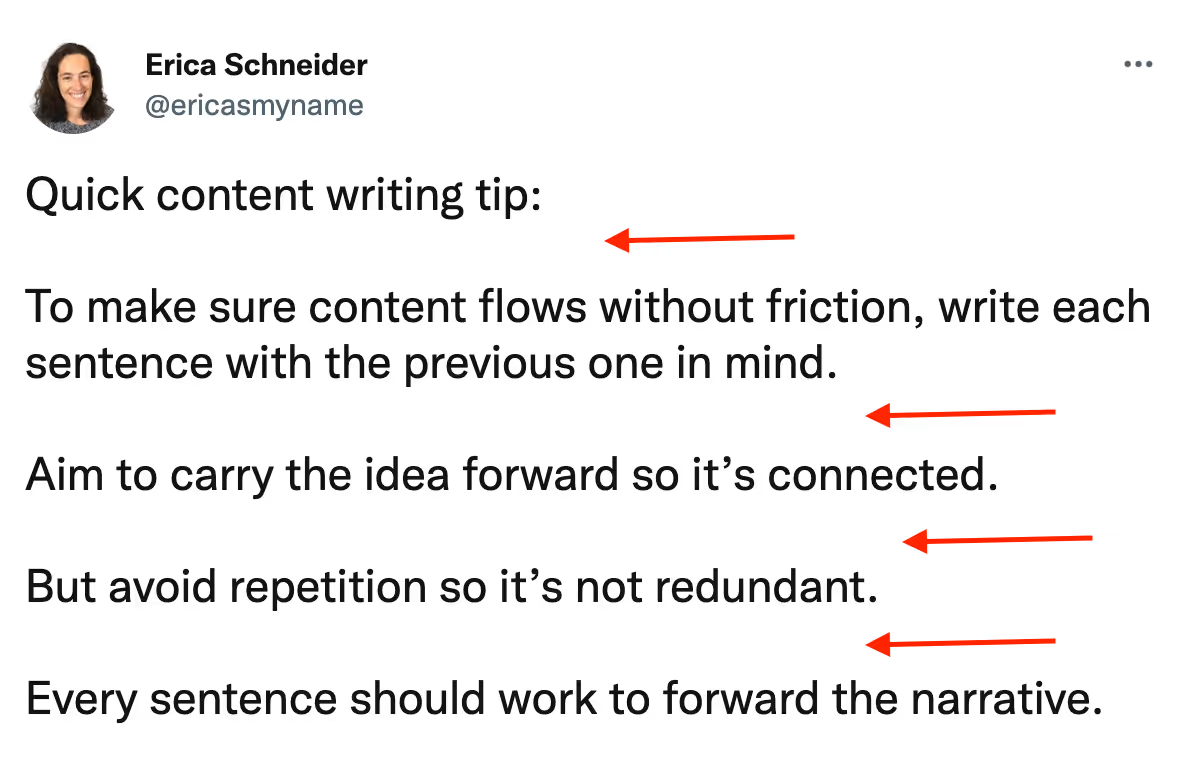
Here’s a meta example of how you could use this format to explain why this advice will help people write stronger Tweets:
- Header: “Answer intent right away”
- Subheader: “This way, the reader understands why what they're about to read matters.”
- Body: “Include data points or personal anecdotes so the reader can picture themselves doing what you’re describing.”
- Takeaway: “Small tweaks like this make a big impact on flow and drive engagement.”
And here’s a simplified version of how we could format a tweet when giving the advice “break up long walls of text”:
- Header: “Break up long walls of text”
- Subheader: “White space helps skimmers and makes content easier to digest & navigate.”
- Body: “Try to limit paragraphs to 2-3 sentences max.”
- Takeaway: “The reading experience matters as much as the words on the page.”
Add your CTA to the final tweet in the thread. Here’s what my thread CTA looked like when I promoted the Quality Content Marketing article referenced above:
I talk about all of this in detail in an article I recently published on the @getgrizzle blog.
— Erica Schneider (@ericasmyname) August 31, 2022
Read it to learn how to:
-Build your own editorial standards
-Hire A-players
-Set up organized systemshttps://t.co/W5aF6v5kWD
This only worked because it was tacked onto original content, formatted for Twitter, and referenced themes discussed in the article.
Here’s the hook I used:
Everybody wants to produce quality content.
— Erica Schneider (@ericasmyname) August 31, 2022
But scaling quality is hard.
Many fail.
Here's my framework—everything content creators need to guarantee every piece of content is valuable:
Nothing was copy/pasted. The best-performing repurposed content on Twitter doesn’t feel repurposed—it feels tailored to the unique Twitter experience.
Here’s an example of a body tweet from this thread where I explain what editorial goals are:
🔸 Editorial goals
— Erica Schneider (@ericasmyname) August 31, 2022
The why & the who.
Why you're creating content in the first place.
Who you're creating it for.
E.g.
I am creating content to help people produce better content.
It's for content writers, editors, marketers, and anyone that uses writing to communicate.
Here’s how we talk about editorial goals in the article itself:
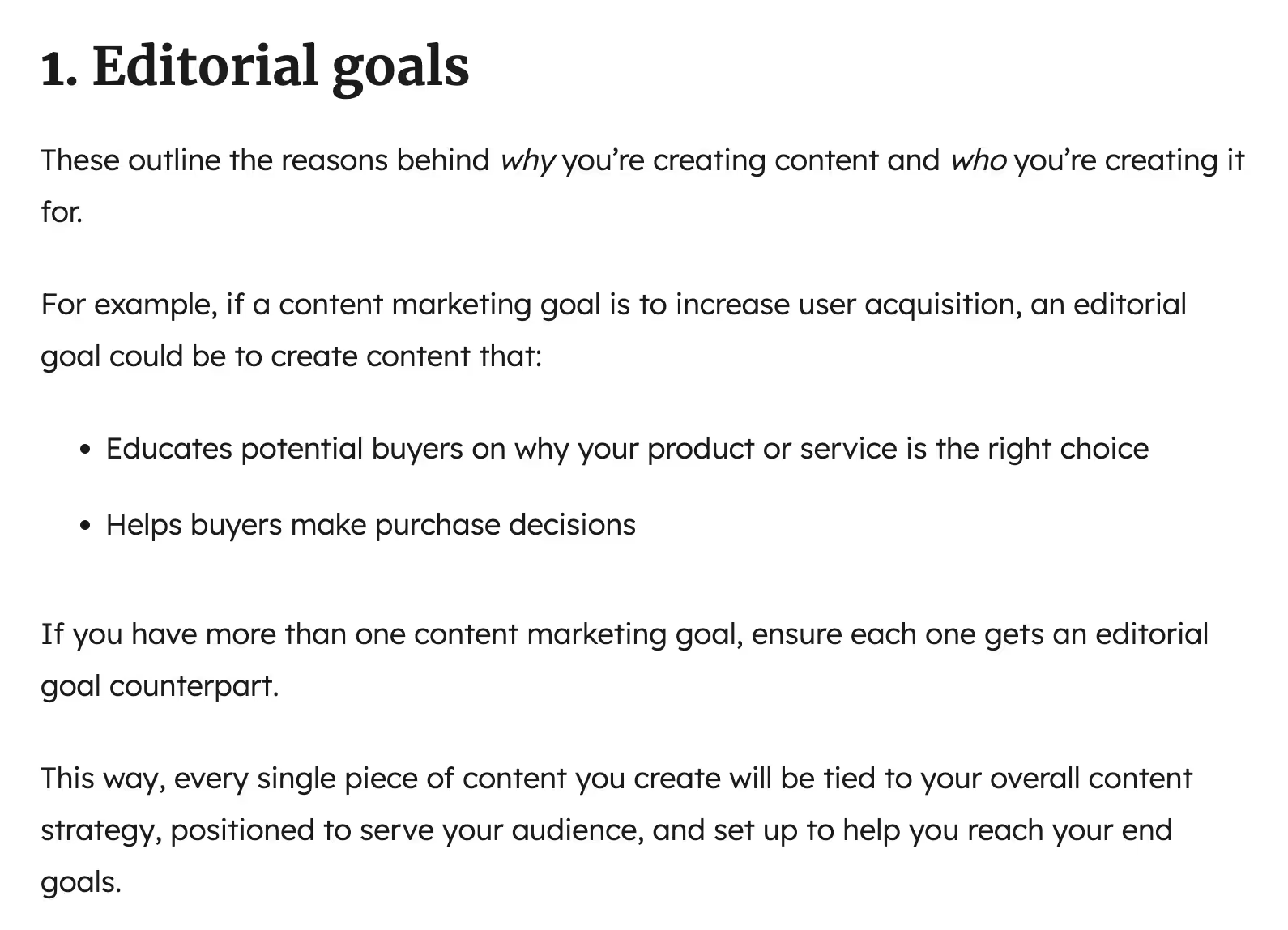
Notice how the examples I picked are completely different. In the article, our target audience is marketers that would benefit from seeing what a relevant content goal looks like.
On Twitter, my audience is a mix of content marketers, writers, and editors looking to improve their written communication skills.
I tailored each example to the audience at hand and structured the content to the format at play. It’s not repurposed; it's reimagined.
Interestingly, I chose to include a second hook in this thread:
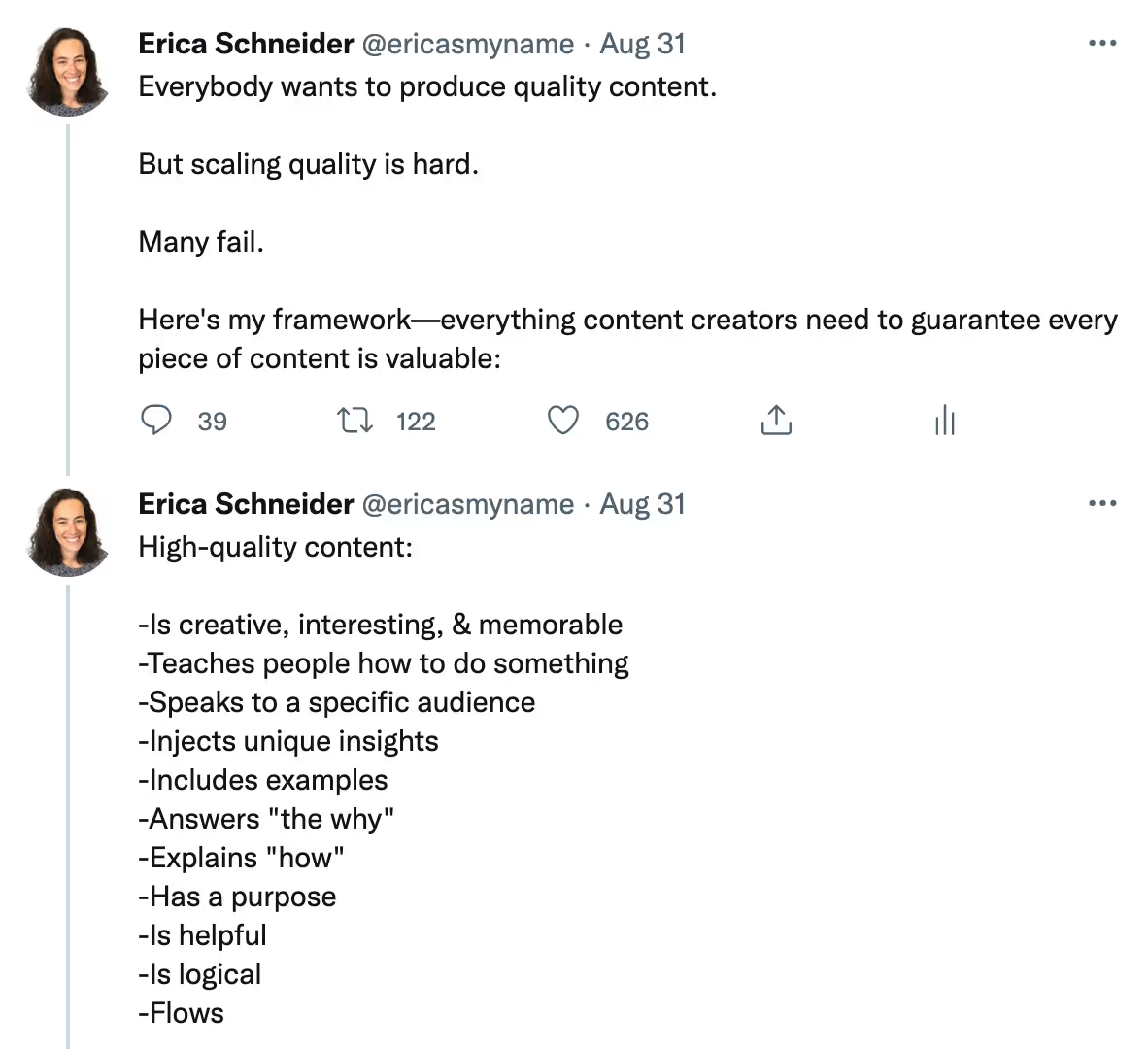
And it got 3x more likes than every other body tweet:
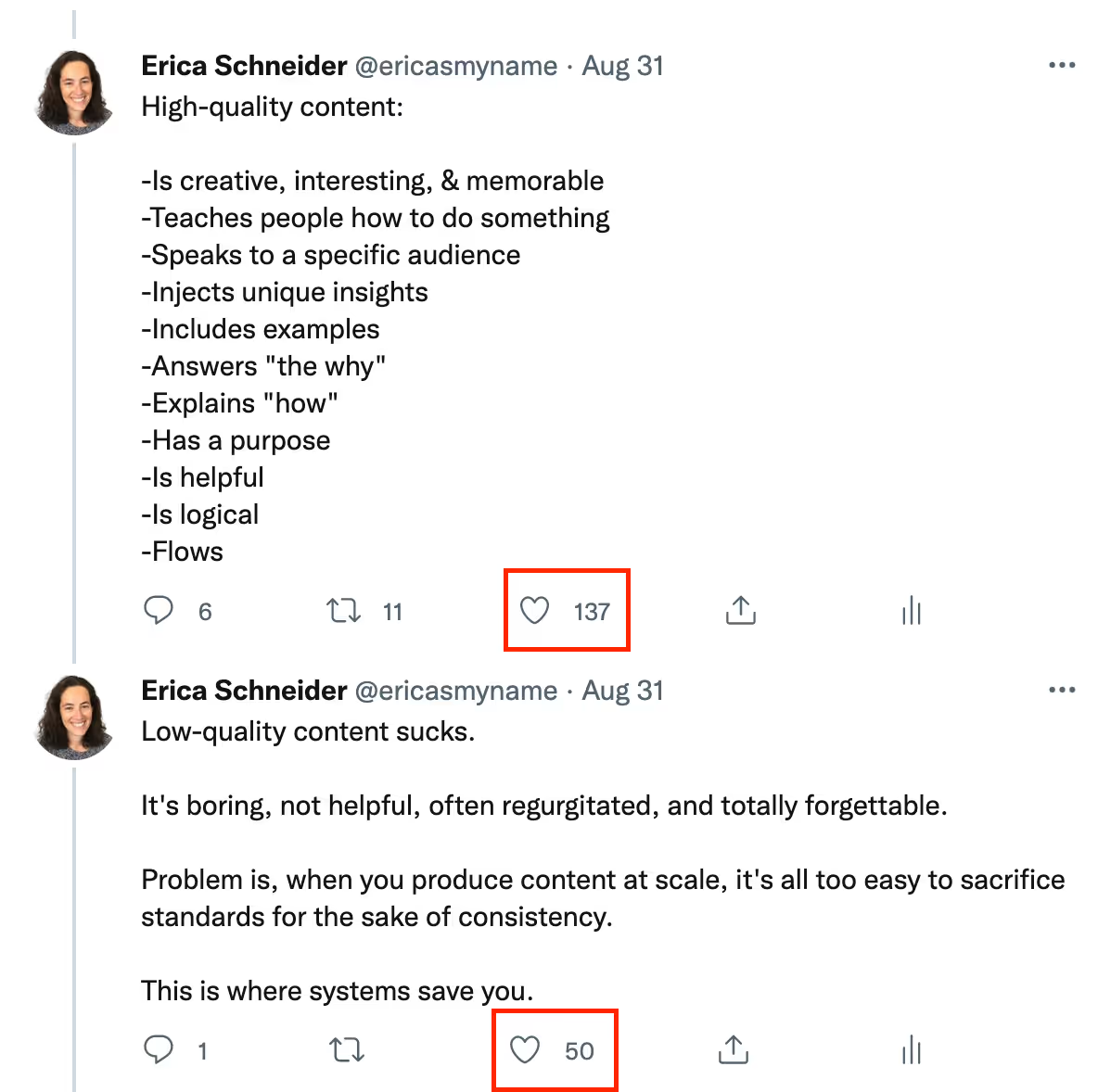
That’s because frontloading value, credibility, and getting ahead of objections works well on Twitter.
In my first hook, I argue that quality content is important but I don’t explain why. To get ahead of objections and prove my point, I used the second tweet to prove:
- I know what I’m talking about
- Here are all the reasons why quality matters
- I’m about to back this up with specifics so keep reading
If the reader wasn’t entirely hooked after reading tweet 1, they certainly are after tweet 2.
This second hook is also a perfect single tweet. Here’s why.
How to write single tweets that drive engagement
The reason why the second hook above performed so well is because it teaches and is uniquely structured for the platform.
Notice how the sentence length cascades from long to short as you read from top to bottom. This is visually engrossing and works to capture attention.
But not every tweet needs to be so obviously structured for the platform.
This quick tip performed well because it poked at a common pain point (everybody wants to make it big, fast), gave advice backed by years of experience, and spoke truth to unrealistic expectations:
How to be "an overnight success" in any industry:
— Katelyn Bourgoin ⚡️ (@KateBour) August 6, 2019
Work for 5, 10 or even 20 years under the radar making oodles of mistakes until you finally get a big break.
That's it. That's the secret.
Humorous responses to industry trends or new data are also a great way to start a conversation and let your personality shine through:
I have a headache. pic.twitter.com/oG7bf9v7lp
— Jason Bradwell 👋 (@JasonRBradwell) September 12, 2022
What B2B marketer hasn’t seen that infographic by now? It’s relatable and makes you want to run to leave a comment.
In general, single tweets give you a chance to demonstrate your personality. They also challenge you to share valuable advice in a short format—which is excellent practice for cutting fluff and redundancy from your writing.
There’s no “perfect” format for single tweets, nor should there be. As long as they’re tailored towards your target audience, you can get creative, share opinions, ask engaging questions, and have a little fun:
To those of us who save memes to post later but never use them, hi🫣
— Janet Machuka (@janetmachuka_) June 25, 2022
The more relatable and resonating, the bigger chance you’ll strengthen existing connections and attract new followers (that may turn into customers one day).
Ignore Twitter and leave relationships on the table
Since joining Twitter we’ve attracted and converted more leads at Grizzle in a shorter period of time than ever before.
All through organic posts and zero targeted outreach.
Posting daily and providing value has shown potential clients that we know how to create quality content.
If you’re sleeping on Twitter or annoyed by how clickbaity and regurgitated content there can feel, you’re ignoring its massive potential. When you mute the noise and focus on your personal and business growth, you build strong relationships that lead to new business opportunities.
Of course, if the idea of doing it yourself is too painful or you don’t have time, you can also work with experts to write social content for you.

In this article, you’ll learn how to strategically choose content topics that align with all of your business goals; whether that be lead generation, acquisition or retention.
We’ll share content ideation methods used at Grizzle, as well as those used by content marketers at companies like Databox, ConversionXL and Braze.
1. Tapping into sales and customer success teams
Does your marketing team work in a silo, away from sales and customer success teams? You could be missing out on an array of content ideation opportunities to support prospects across the entire buyer journey.
Below are some tips to help you collaborate with sales and customer success teams:
Supporting your sales teams and generate leads
Lead generation is, of course, a key sales metric. And most sales teams would be grateful for content that answers common queries they hear from leads on a daily basis.
This will enable them to spend less time answering repetitive questions, and more time closing deals!
Here’s how to generate a pool of content ideas that help support your sales team and generate leads at the same time:
Interview sales managers and SDRs
Interview sales reps and managers to understand the sales cycle, their biggest goals and common pain-points or questions they hear from prospects. You can get rich, honest insights by interviewing sales members.
Pro tip: Record and transcribe these interviews and repurpose quotes in future pieces of content. This will help you collect deep, qualitative insights you can refer to when expanding your buyer personas, while positioning your salespeople as experts at the same time.
Here are some questions you can ask sales reps to elicit insights for your content ideation process:
- What are some common challenges prospects bring up again and again?
- Which part of our product/service makes prospects light up?
- Which content would you find most helpful to provide prospects?
- What are the main sales metrics you need to meet?
- What are the common queries you get from prospects?
- What are common sales objections you get across the sales journey?
- Are you happy with current sales materials?
- Can you explain the internal sales process? E.g from first point of contact to closing
- Which sales questions do you struggle to answer the most?
- Which sales materials do you most regularly send leads?
Audit and optimise your sales material
Ask your sales teams to send you the content they use on a regular basis. This can include:
- Any white papers, case studies etc. they regularly send to prospects
- Email outreach templates
- Template responses used for FAQs
Add these to a spreadsheet and note at which stage of the sales cycle materials are used, the traffic to these pages (if relevant), and quality of the content.
This exercise should help you notice obvious gaps and content that needs refreshing. For example, case study pages may get high traffic, but be thin in value and show low “time spent on page”. Refreshing case studies may be a priority area.
Sit in on sales calls (or request recordings)
Sitting in on sales calls will let you grasp objections from the perspective of a potential customer. You may pick up blind spots that weren’t picked up by speaking to the sales team alone.
As Emily Byford, B2B Content Marketer, says:
“Listen to your customers, listen to your sales team. If possible, get your sales team to record their calls, and make a habit of listening to a couple a week. This will help you understand what matters most to your potential customers – the problems they’re *really* looking to solve. What are the questions they ask most often? Use this to prioritise the content you’re planning.”
Once you’ve captured all this information from the sales team and your audits, present a shortlist of topics to the team about which you’ll be prioritizing for the next quarter.
Supporting customer success teams to boost retention (and prevent churn)
Customer success teams want to delight customers and prevent churn. Content can help support customers during this journey.
Below, similar to the section above, is an approach to help you generate a pool of content ideas for your customer success team.
Interview members of the customer success team
Just like you did with sales, fresh insights can be yielded from customer success teams. They speak with customers on a daily basis, and they can bring a different perspective than sales teams.
Some example questions include:
- What do clients love about our product/service?
- What are the common woes (both product and non-product related) that customers talk about?
- What are the customer success team’s goals and success metrics?
- What does the customer onboarding process look like?
- What is the big problem our customers are looking to solve by using our product?
- What are the most common reasons customers churn?
- What are the most frequently asked questions from clients?
- What content would be most helpful to send new customers?
- Best customer success stories?
Compile an audit of current customer success materials
Request to be sent all the current customer success materials in use and create a spreadsheet listing all of these.
Sit in on an onboarding call and a customer check-in call
Listening in on customer calls will help you empathise with customers and uncover content topics that you may not have thought of by talking to internal teams alone.
Agree on topics that will empower customer success
Once you’ve captured all this information, present a shortlist of topics to the customer success team about which you’ll be prioritizing.
I spoke with Todd Grennan, Managing Editor at Braze, who explained how he uses a similar process of interviewing different department representatives to plan each quarter’s topics:
“We operate on a quarterly schedule, aligned with the rest of the business. A month before the end of the previous quarter, my team starts having 1:1 meetings with representatives of other departments in the organisation. We basically sit down with them for half an hour each and talk through what their focus is for the next 3 months, what their business concerns are, what they’re seeing in the market etc.
Often, one of the biggest signals regarding whether there’s a topic we ought to take on is when we hear from disparate departments that a particular topic is a major topic of focus for them. This is usually a sign that this is a topic worth diving into that hasn’t caught on our radar yet.
Usually we take the raw material from these interviews and take that in concert with any demand generation information we have for the quarter. We don’t want to have tunnel vision when it comes to serving internal needs but we also want to make sure that any insights various teams have seen in the market are cared about, particularly if they have relevance for our audience.”
2. Finding SEO-driven topics to increase organic traffic
Below are some tactics to help your content rank on Google; an SEO-first approach to content ideation.
Chris Newton, Inbound Marketing Manager at Klaviyo, explains what we mean by an ‘SEO-first’ approach to support users looking for answers through search engines:
“Content ideation at Klaviyo used to follow an “SEO-second approach” but I’m establishing an SEO-first approach. People would often come to me with a blog post and say ‘can you optimise this for SEO’ after the fact. I find those don’t always tend to perform as well as posts where we identified the topic we want to write about first and then write the post specifically around a certain keyword that we’re trying to optimise for. I call that the SEO-first approach.
I think that as the year goes on, we’re going to be taking more of an SEO-first approach to content ideation.”
How to discover keywords for SEO-first content
When it comes to uncovering SEO-friendly topics, it’s important to begin with some keyword research.
Start by listing keywords you think your target audience would be searching for.
If you’re not sure where to start, have a look at blogs of your competitors. Input their URLs into a tool like Ahrefs, Ubersuggest, or SEMRush and you’ll see which keywords these posts rank for, as Automate.io’s Sr. Content Marketer, Archita Sharma suggests:
Use a tool like Ahrefs to check out your competitor’s keywords and get an understanding of what worked well for them! A simple lookup in Ahrefs’ Content Explorer would show you which keywords, which links are already ranking and how competitive these keywords are. Target these hot keywords and set up your content pipeline accordingly.
Next, punch your chosen keywords to an SEO tool like Ahrefs, which will show you will show you keyword ideas and similar keywords, allowing you to build upon your initial keyword list:

You can even use Google and look at the ‘searches related to’ terms that come up:

Make a note of the average monthly search volume for each keyword, along with the difficulty:
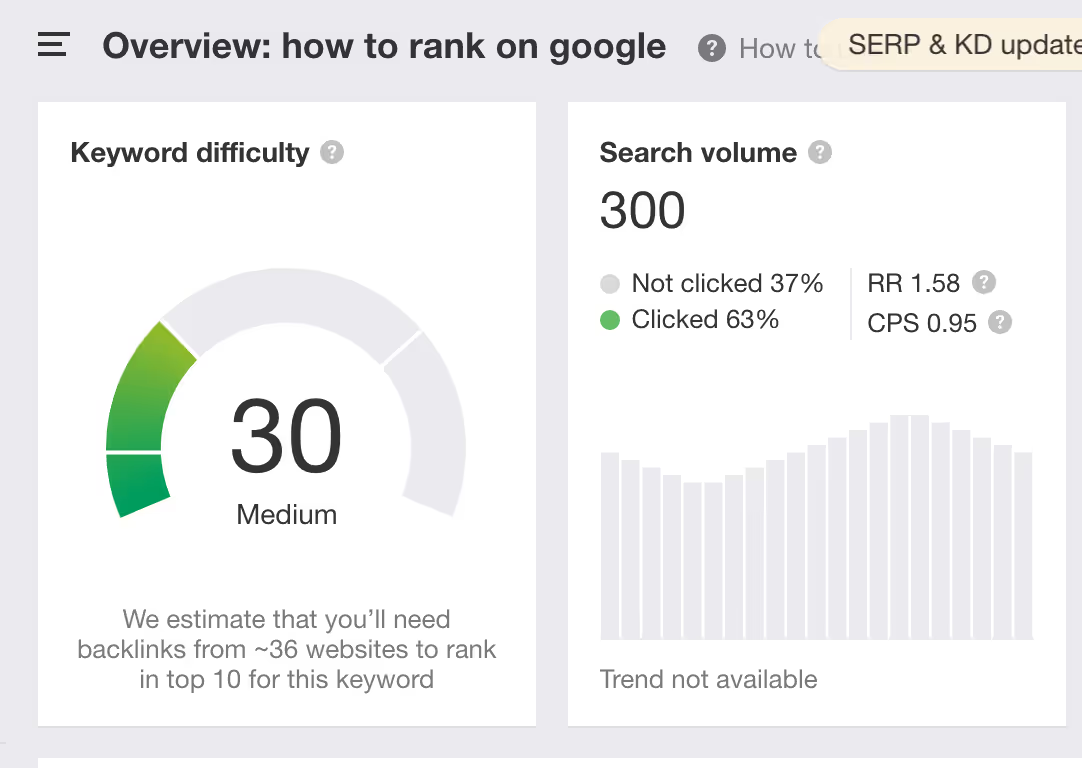
Next, use a tool or a simple incognito search to see which content is ranking on page one of Google’s SERPs:
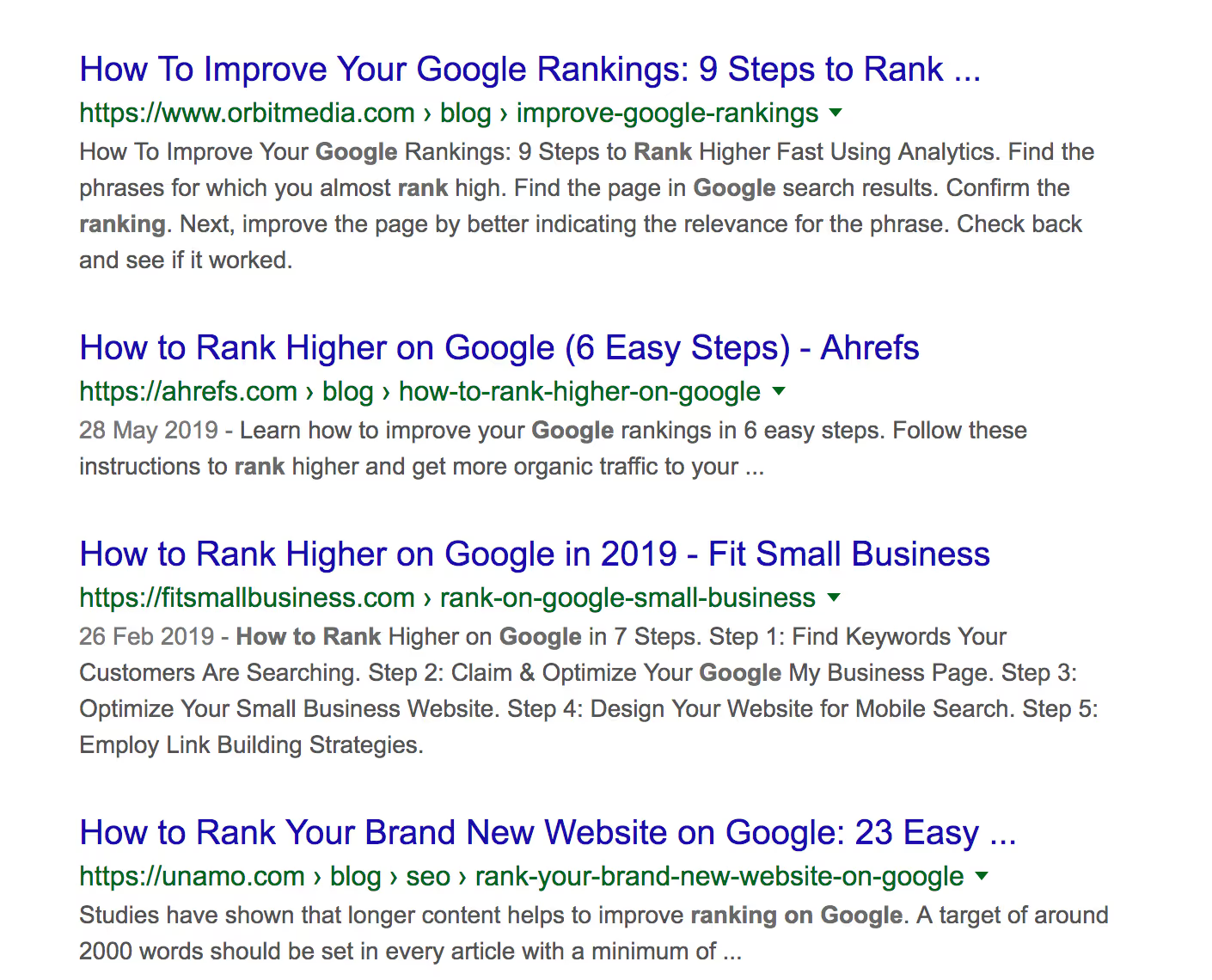
Note down the content titles, assumed search intent per result (are the topics mainly step-by-step articles? News articles?) and the quality of the top 5 SERP results.
A tool like Clearscope will automatically give you this information to help you see areas to outshine the competitor content. Check which other keywords the top domain rank for: Input the domains for the top 5 results into a tool like SEMRush, Ahrefs or Ubersuggest.
Once you’ve gathered all this information, utilize this data to choose SEO-first topic opportunities. You may choose a buffet of topics. Perhaps a couple of 10x pieces to outshine the competition when it comes to high traffic, high competition topics.
You could also sweep up a bunch niche topics that you’ve identified as having low traffic, low competition.
Focus on niche content hubs to rank a new blog
It can be difficult for newer blogs to compete with content from authoritative sites when it comes to organic search.
Derek Gleason, Content Lead at ConversionXL, explains the ‘hub-and-spoke’ strategy that newer sites can utilize to create content that ranks in Google:
For newer sites, content ideation is pretty simple: Pick a topic that’s:
1. Relevant to your company or product
2.For which you can claim authority
3. For which there’s search volume
Then, cover the core topic and its tangents—a hub-and-spoke strategy, essentially.
For example, in my previous work at an agency, a client managed several pediatric urgent care centers. While anything relevant to healthcare could qualify as a potential topic, we wanted them to narrow the focus to their deepest expertise.
Ultimately, it made the most sense for them to answer the question, “Should I take my child to urgent care or the ER?”. We identified about a dozen posts on topics like “When is a fever dangerous?” and “Can you get stitches at urgent care?”
Google rewarded the narrow focus of our mini-hub, and – despite being a small site with unremarkable domain authority – they rank highly on Page 1 for several “Your Money or Your Life” queries that receive added scrutiny from Google.
When users come to any page, we want them to:
1) Know – know what the page is about
2) Feel – feel that the page gives them the right solution
3) Commit – commit to one single action
In terms of the ideation stage, Chris Old from IG suggests using KFC to get a ‘bucket’ of actionable ideas in the following way:
- KNOW – Leverage the expertise of subject-matter authorities in your business. Ask them to post-it note all the key things your company offers.
- FEEL – Once they’ve done that, expand on all those key concepts with anything you could write about on those topics. Udemy is another good resource for expanding on topics – check their table of contents for courses on given subjects. Or do it the old-fashioned way – have a look down Waterstones for books on the subject and see how they structure the content.
- KNOW/FEEL – Once you have all the ideas, categorise them into content clusters and run them through a keyword research tool to see where demand is. That means the keywords you’ve considered, any similar keywords you find, plus keywords the current ranking content is showing up for.
- KNOW/FEEL – Re-categorise your clusters based on demand. You should have one ‘blockbuster article’ or page for each topic, with off-shoot shorter articles expanding on it where there is demand. Have a super-interesting idea with no search volume? Add it to the hub article.
- COMMIT – For each topic cluster, what is the one thing you want users to do? Expand on that for every page within the cluster – what’s the one action you want them to commit to? This should be the first consideration when briefing the content.
- KNOW/FEEL/COMMIT – Now you have everything in place, it’s time to brief the content. That means the usual stuff – H1, H2s, title tag, keywords, Schema markup etc. But we don’t want to lose site of our KFC. Start with the ‘commit’, as above, then also brief in what you want users to ‘feel’ and ‘know’ from each page.
This approach ensures both Google and users see clearly organised content and a sound internal linking structure for each content cluster.
Including the ‘commit’ ensures you give users what they want at the endgame, and coax them into taking that action. And the ‘feel’ ensures they are comfortable to so and more engaged with the page. That, in turn is good for engagement metrics Google may be measuring, while also boosting semantic relevance around the topic.
The only pitfall to avoid: do not create too many off-shoot articles if there is limited demand or overlap between the content. You don’t want Google’s robots to be confused about which pages to rank for what keywords.
Steps to hub and spoke topic ideation:
Here’s a step-by-step approach to help your new website rank well in Google:
- Select a main keyword that will act as your main hub topic for your target audience . Using Derek’s example above, this could be the keyword “should i take my child to urgent care or the ER?”. This will be your hub topic that spoke topics will branch out from.
- Choose niche keyword topics that supplement the main hub topic. For example, spoke topics that relate to the initial query of “should i take my child to urgent care or the ER” could be “when is a fever dangerous?” and “can you get stitches at urgent care?”. These “spoke” topics expand on the hub topics. They can be separate posts that are also internally linked to from the hub post.
- Connect the hub and spoke topics with a URL hierarchy. Ensure there’s a logical URL hierarchy such as blog/urgent-care for the main hub topic and then blog/urgent-care/fever, blog/urgent-care/stitches for the spoke topics to increase your chances of ranking.
Huge content backlog? Create a comprehensive content inventory
On the other end of the spectrum, if you have a blog with a huge backlog of posts, the content ideation process should begin with a comprehensive audit of all your content.
Derek goes on to explain the process he uses at CXL:
“When I started at CXL a year ago, the content ideation process was quite complex. We had over 600 posts that we’d published over seven years. We had already covered the most relevant topics, often more than once (leading to “keyword cannibalization” issues). To succeed here, I started by building a comprehensive inventory of all content—a taxonomy that grouped posts into categories and subcategories.
The taxonomy has made it much quicker to help authors identify a topic that’s new to the blog and, ideally, covers an obvious content gap. For example, we recently published a post on how to identify SaaS metrics; we’ve written posts for SaaS companies many times before (and written about analytics dozens of times, too), but we’d never dedicated a post exclusively to SaaS metrics. I doubt we would’ve spotted that opportunity so quickly without an on-demand catalog of our existing content).
Admittedly, we’re very focused on organic search—it accounts for the lion’s share of our traffic. The content ideation process is different if you’re angling for social shares or links (although high-ranking content earns many “passive” links by ranking at the top of page 1. The takeaway is that your distribution strategy should inform your content ideation, not the other way around. You might have an incredible idea for a post, but if it requires a paid social media budget that you don’t have or an army of outreach specialists that you haven’t employed to get visibility, it will fail”
– Derek Gleason, Content Lead at ConversionXL
3. Product-Driven Content that Attracts Buyers
For many marketers, converting readers into leads and customers is a core content goal.
Which is why creating challenge-driven content, based on the needs and pains of your buyer persona, can be a great source for content ideas.
These are simple topics that dive into customer pain points that your product or solution solves.
Here’s a step-by-step approach to product-driven content:
Step 1: Identify which landing pages you want to drive traffic to
If you’re unsure which landing pages to prioritize, start off with an audit of your current product pages.
Gathering this data will give you an informed decision regarding which product pages to prioritise and let you see whether your new content has had the impact you hoped for down the line.
Product page data you could gather:
- Current traffic for each product page:
- “Previous page path” for current product pages via Google Analytics: Which pieces of content are already driving readers to your product pages?
- Conversion rate for current product pages: If you’ve setup Goals in Google Analytics or a have CRM like HubSpot, you’ll be able to see the conversion rate of each product page (whether that be free trial sign-ups, demo requests, or purchases).
Use this data to shortlist the product pages that need more traffic. For example, if there’s a highly converting product page with low traffic, you may want to prioritize content topic ideas that link to that page.
Step 2: Identify which pain points are solved by your product
Next, have a deeper look at the product pages you’ve identified. Note which pains are solved by the solution described on each product page:

Choose content topics about the specific pain points you’ve identified. Add a CTA to the connected product page that illustrates how you solution solves that pain point.
For example if your product page explains how your app relieves the manual effort of exporting spreadsheets, choose content topics like “tips to stop spend hours manually processing spreadsheet data”. Your solution solves this pain point so it would be natural to include a CTA to the matching landing page. Ensure you blogging efforts work with product pages.
4. Generating Product Demand with Top-of-Funnel Topics
Let’s look at choosing content topics to drive top of funnel engagement and traffic. Top of funnel content refers to posts that address problems experienced by your target audience.
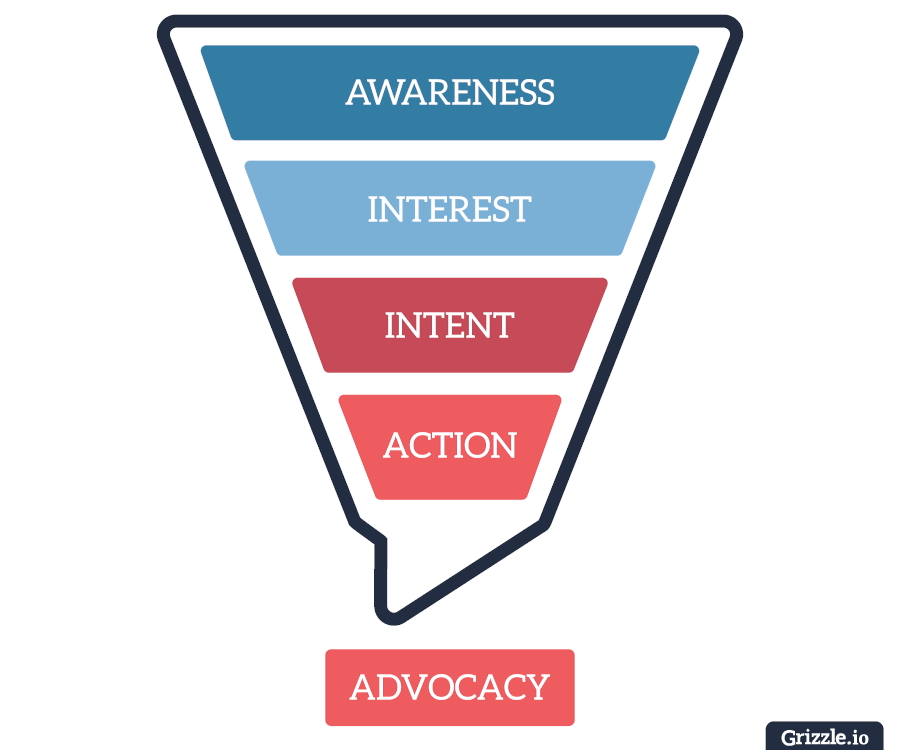
Interview your target audience
Interview your target audience about their challenges to collate a buffet of top-of-funnel content ideas. You’ll uncover nuanced topics that are difficult to pick up through online research alone.
The most recent posts (including this one!) on Grizzle’s blog have come into fruition from this interview method:
- Contact a bunch of people belonging to your target audience that you’d love to interview
- Organise 30-minute calls with 3-5 of them
- During the interviews, ask about their goals, biggest challenges and approaches to problems. Ask lots of follow-up questions to get to the nitty-gritty!
- Make a shortlist of commonly mentioned pain points from your interviewees. You should begin to notice a pattern of nuanced pain points and topics that have emerged
Target audience interviews give you the added benefits of developing long-term relationships with your sector, a deeper understanding of your audience, and quotes you can inject into blog posts (or even a podcast) too.
Crowdsource ideas from your target audience
Databox have a super-organised way of collating ideas from their target audience, as their CEO, Pete Caputa explained to me:
“We collect 100s of content ideas from our writers and readers every month. For most of our content, we are sourcing contributions from experts. We do this by asking 25-50 experts one question, then weaving the best answers together into a long guide on the subject. At the same time, we ask them, “What articles would you like us to write next?” We also invite our freelance writers to pitch us ideas. We review the suggestions and pick the best 5-6 each week”
– Pete Caputa, CEO at Databox
[[component]]
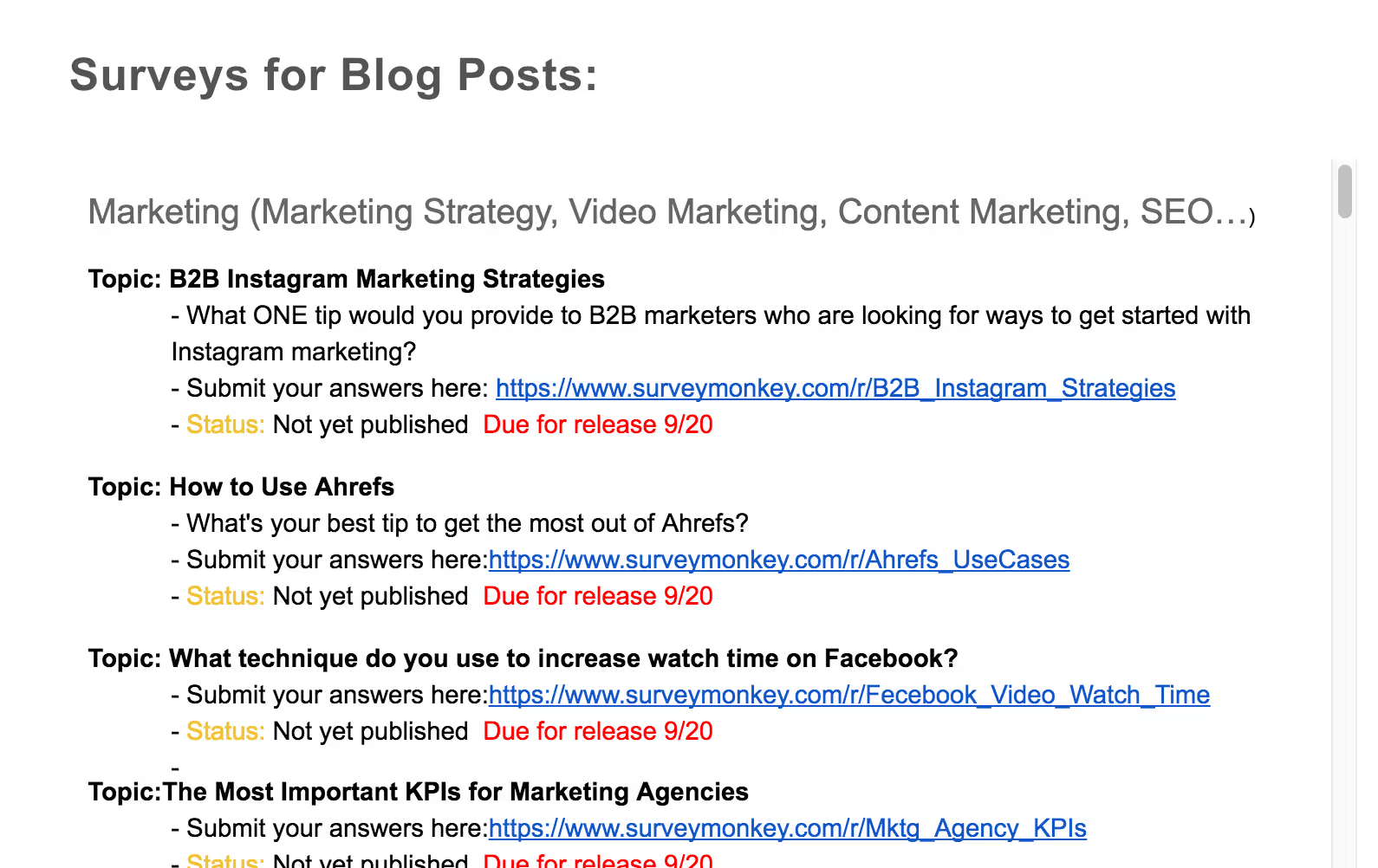
Refresh old content ideas
Sometimes you don’t need to reinvent the wheel when it comes to great content ideas! If you’ve got a backlog of old content, refreshing old posts can do wonders, as Chris from Klaviyo explains:
“I’m a huge fan of going through old posts and re-optimising them with new data and new insights for a new audience. We have a ton of posts going back from 2015, 2016, 2017, and, with just a few optimisations and edits, we can give them new legs. That’s a big goal of our managing editor.”
– Chris Newton, Inbound Marketing Manager at Klaviyo
Identify sharable topics using BuzzSumo
Buzzsumo can help you identify topics that thrive on popular social channels like Reddit, Twitter, Facebook (Quora isn’t currently included).
Let’s say you want to write about topics around the general theme of “social media marketing”. You can run that search term and see the most socially shared posts via Buzzsumo’s ‘content analyzer’ tool.:
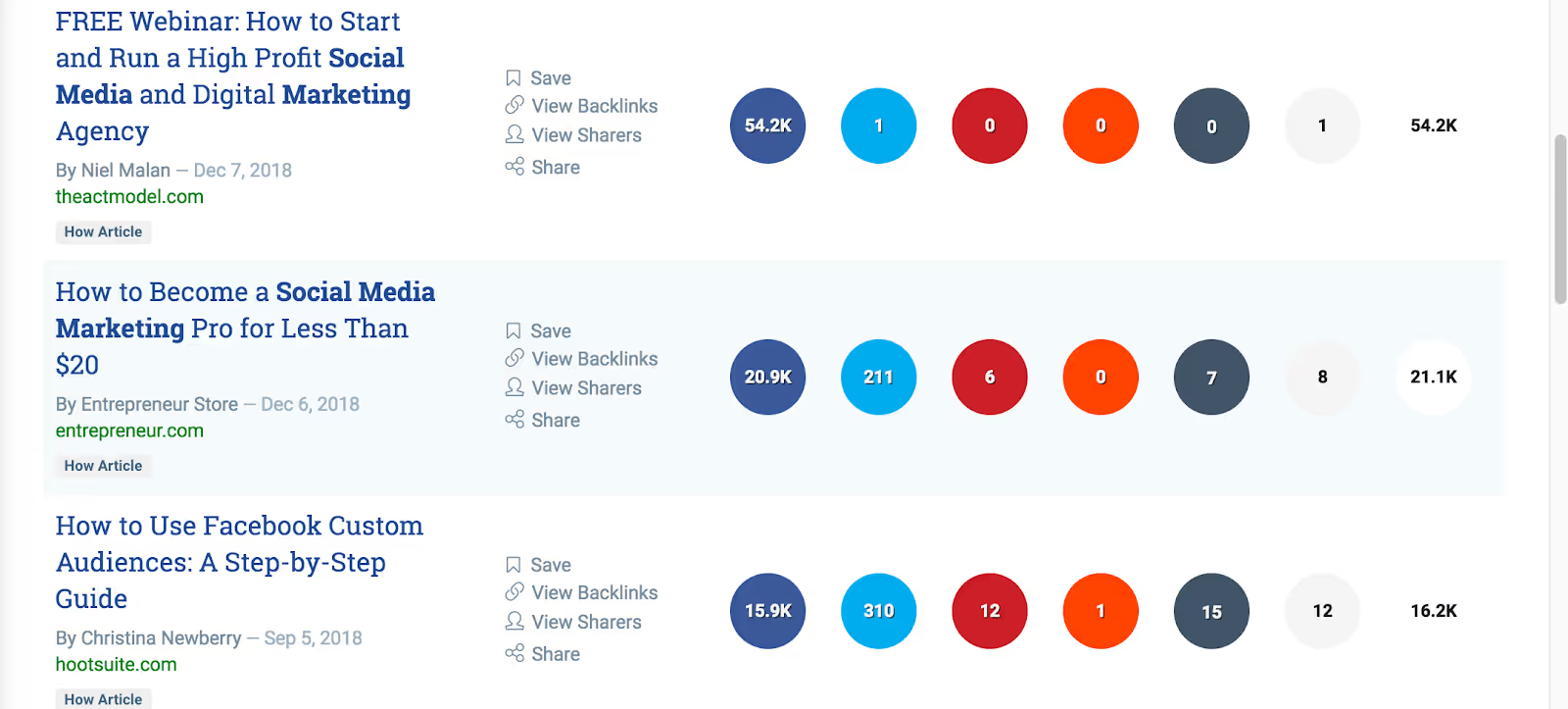
You can identify from this list which topics tend to be more widely shared than others.
You can take that a step further and click ‘view sharers’ for each post:
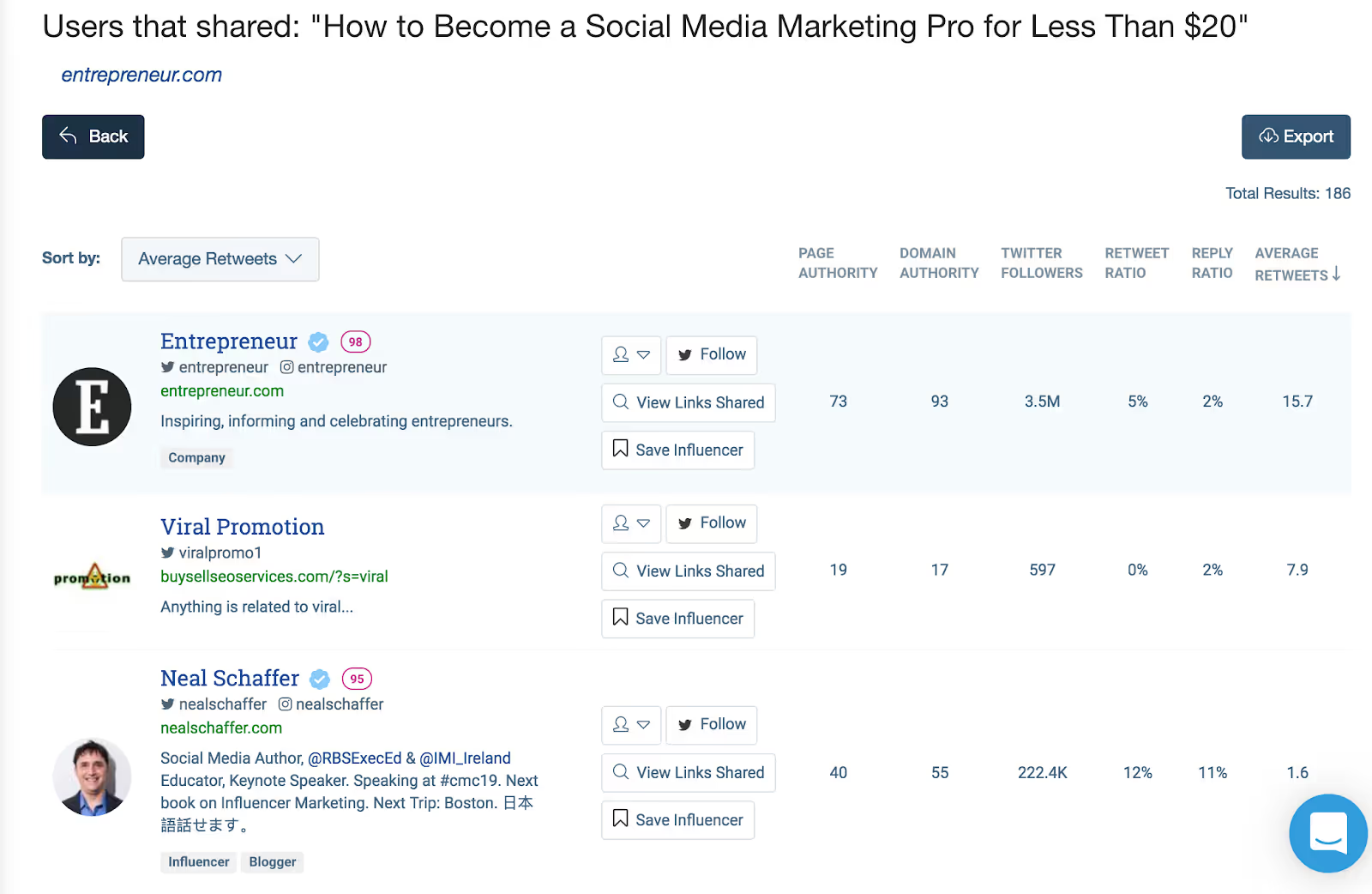
Not only will you identify influencers for certain topics (who you can contact to share your own posts) but you can also look at other content shared by those influencers for further topic ideas. Read more on connecting with B2B influencers here.
Conclusion
As covered, there is no one-size-fits-all approach to content ideation. It’s important to get clear about your goals before choosing a framework for topic ideas.
Here’s a recap of which content ideation frameworks you can use depending on your goal:
Organic traffic goals: SEO-first ideas using search tools and keyword research should be the base of your content ideation. Hub & spoke approaches are ideal for new blogs.
Conversion goals: Run an audit of your product pages and then choose content topics around pain points that your product solves
Target audience engagement goals: in-depth interviews with your target audience will help you identify nuanced pain points and patterns
Social sharing goals: Use a social sharing tool like Buzzsumo to identify which topics are frequently shared across different social media channels
Supporting your sales and customer success teams (lead generation and retention goals): Interview your sales & customer success teams and run audits of current materials.

SaaS and B2B brands must be more discerning with their content and SEO priorities and choose a strategy that builds authority, generates traffic, and drives revenue.
Competing with powerhouse players becomes a non-issue when you narrow your focus to specific, relevant topics. Casting too wide of a net right away won’t help you form a cohesive narrative, and authority will take longer to build.
To accelerate growth and generate quality search traffic, you need to tell a unified story with your content, one chapter at a time.
The best way to do this is with topical authority. It fuels perceived knowledge, establishes credibility, and positions you as an expert worth paying attention to.
Topical authority is critical for accelerating organic growth
When you build authority around a topic with little competition that aligns closely with your value proposition, you emerge as a voice of authority.
Once you’ve built trust, momentum takes over and people begin to pay attention to everything you publish.
By the time you become a go-to resource on a topic, your audience will acknowledge you as an expert in that space.
Topical authority goes beyond perceived value and trust with people—it also signals to Google that your content is important.
That’s because Google algorithmically prioritizes E-A-T (expertise, authority, trust).
EAT plays a key role in how Google determines search quality. It looks at the creator behind the content and how authoritative and trustworthy that author or brand is.
Google understands that people want complete answers to their questions, from credible and non-scammy sources, so that they can have a satisfying search experience.
Topical authority, therefore, is a strategic play to cater to both algorithmic and psychological preferences. For startups, it’s a far better goal to aim for than domain authority (DA) or domain rating (DR).
If you consistently prove your value, your audience and Google alike will consider you a trustworthy source worth holding in high regard. This has two key ripple effects:
- If your content is useful, helpful, and interesting, people will decide it’s worth reading and Google will decide it’s worth ranking.
- If you consistently produce relevant content on a topic, people will decide it’s credible and Google will decide it has a high level of expertise, authoritativeness, and trustworthiness (and continue to rank it).
As such, topic clusters are the preeminent vehicle to demonstrate knowledge and expertise, accelerate search visibility, and enter the consideration set with your ICP—even in competitive markets.
We followed this strategy with an asynchronous communication SaaS client. Here’s an example of what happens when we publish competitive and commercially-relevant articles on meeting-related topics:

Compare this to another article in the broader “remote working” space:

The meeting-related article ranked on page one within the month. Conversely, the broader remote working article fluctuated between positions 42 and 21 from August until April before stabilizing between positions 9 and 11.
Could we have improved the performance of the broader article? Yes, but that’s not where our priorities lay.
Our goal is to generate relevant traffic and turn SEO into a revenue generating channel, which can only be done by building topical authority in a space aligned with our client’s value proposition. And it works—the blog is responsible for ~33% of new user sign-ups.
Relevant content amplifies the impact of your resources
When you focus on one topic cluster at a time, results compound across all content assets.
For example, say you offer candidate tracking software for hiring managers. You may wish to focus on creating content around the topic cluster “talent acquisition”. This effort will compound the more you publish content within this topic (as demonstrated in the example above).
If you were to produce 12 articles on various HR-related topics, on the other hand, you’d merely dip your toe in each pool, slowing down the speed at which you build topical authority.
Critically, topical authority also helps you gain more quality backlinks. If your brand becomes an industry authority known for sharing quality information, people are more likely to link to your content (more on why and how to do this later).
This is how sites with low DA or DR can rank amongst established players—they’ve reassured Google that the content will meet and exceed search intent.
How to build compounding topical authority using the Hub & Spoke model
The hub & spoke model is how you generate and distribute content around a topic cluster. The hub covers the baseline topic (usually a cluster of high-volume or competitive keywords), while the spokes cover specific topics nested below it (often lower-volume and long tail in nature).
When you strategically organize the relationship between your content, you create structure and cohesion.
To get it right, you’ll need to:
- Conduct keyword research and organize them into clusters
- Meticulously map out how these keyword clusters relate to each other
- Identify the purpose of each article (the traditional funnel is a good model for this)

The hub serves as a “home base” while acting as a long-term traffic play. It may take longer to rank, but your chances multiply by covering other areas of the topic.
With keywords in hand, you can get to work.
1. Prioritize topics that align with your solution
Start with your audience’s biggest jobs-to-be-done (JTBD). Provide relevant, helpful, and intriguing content that:
- Presents new and better ways of doing things
- Positions your brand an an authority
- Promotes your solution as the best choice to solve their problems
When you produce comprehensive and topically relevant content, you’ll develop brand equity that drives leads, users, and advocates.
Returning to our candidate tracking software example, we chose the hypothetical “talent acquisition” topic cluster because HR (and even “hiring”) has lots of search opportunities but it’s too broad. You could write about onboarding, company culture, relationship management, etc.—all of which are broad themes of their own.
When it comes down to it, “talent acquisition” would be the primary JTBD for this audience. Candidate tracking software helps buyers improve their talent acquisition workflows and experience.
A “talent acquisition” hub, may cover topics like:
- Candidate experiences
- Interviewing candidates
- Job descriptions
- Talent acquisition workflows
- Applicant tracking systems
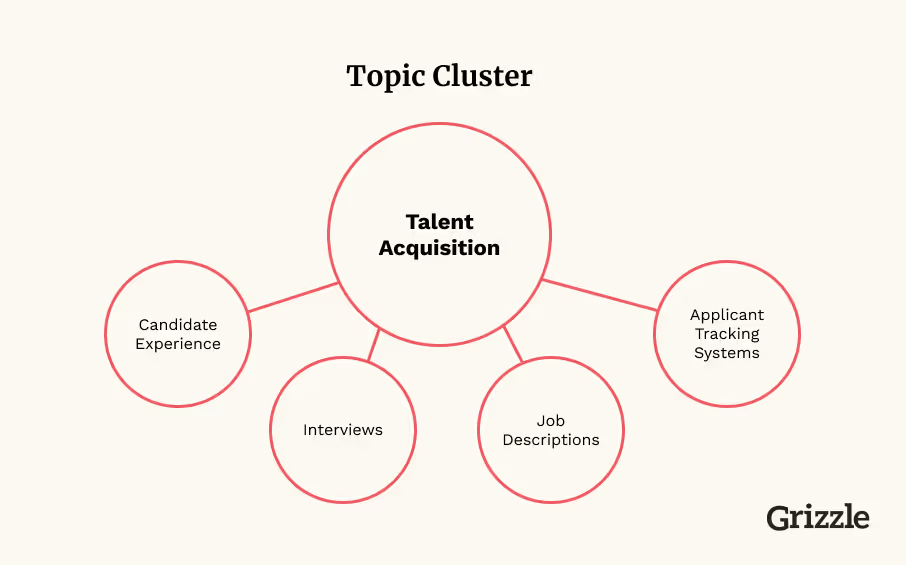
These subtopics align with their product because it directly relates to improving hiring workflows. It also gives them an opportunity to plug their product by showcasing exactly how to use it to build efficiency into the acquisition and interviewing process.
In all, the reader is taken through a helpful journey that motivates them to take action. That could be to read another topic in the cluster, subscribe to a newsletter, or even sign up for a free account (if you’re growing a product-led brand). Topics lower down the funnel might offer demos, consultations, or free trials.
2. Map your topic clusters
By this point, you’ll have various topics that tie to your customer’s goals and pain points. Next, identify which topics belong together in their respective cluster and which will act as the hub.
For example, if you’ve identified various topics around VAT, we can verify that VAT is the hub while specific topics and long-tail keywords like “How much is VAT?” are the spokes.
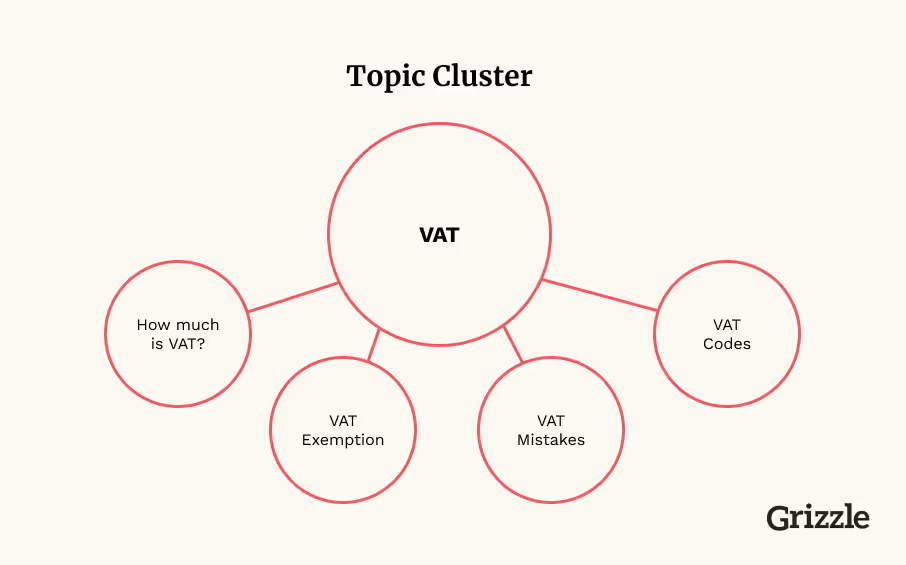
Use keyword clusters to group topics together. This is where queries are “batched” based on search intent and patterns in the SERPs. Tools like Keyword Insights can make this process easier.
For example, if we search for “omnichannel marketing” and “omnichannel marketing examples,” we get the similar results:
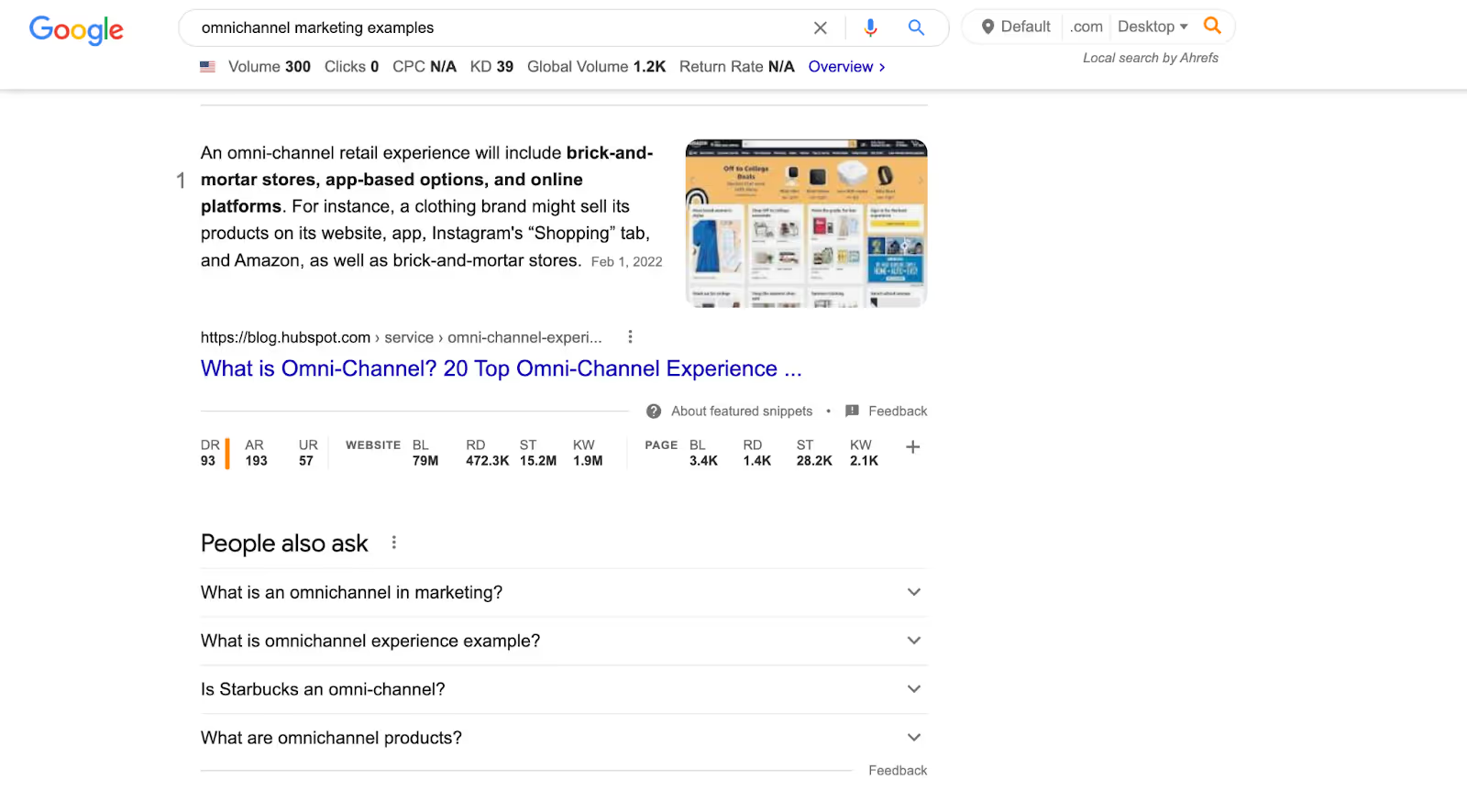
This model will also inform your internal linking strategy. This helps Google determine the relationship between your content and also provides a more helpful (and seamless) experience for readers. It’s also critical for maximizing the impact of your link building, which we’ll cover shortly.
Done right, an article will answer questions fully, but if readers want to learn more, they can click on strategically placed internal links to do a deeper dive.
Within an “Ultimate guide to VAT,” for example, readers can learn more about “How to calculate VAT” by clicking on an internal link or a more prominent “read more” design component.
This removes the need to head back to the SERPs—everything they need is presented to them from a single result.
3. Create content that caters to every stage of the funnel
Your hub & spoke content should touch on every stage of the buyer journey, from awareness to decision.
For example, within the “talent acquisition” hub for our SaaS candidate tracking startup, here’s how we could position spokes throughout the journey:
- Top of funnel: “What is talent acquisition?”
- Middle of funnel: “Best applicant tracking software”
- Bottom of funnel: “Breezy HR alternatives”
The topics move from problem-aware (I need help attracting and recruiting top talent) to solution-aware (I need a tool that helps me manage candidates and improve the hiring experience) to product-aware (evaluating several tools from their consideration set).
We advise creating a balanced content portfolio and steady production cadence across the entire funnel. This will allow you to gain traction on more competitive terms, take advantage of quick-and-easy wins, and generate users and revenue from those middle and bottom of funnel topics.
4. Focus on quality over quantity to signal trust
Bad content ruins a good strategy. You’ll never drive leads and revenue if you can’t provide your audience with helpful, memorable, and unique experiences.
Quality content is critically important—perhaps now more than ever before. According to Semrush’s State of Content Marketing 2022 Global Report, 61% of respondents reported that “making content more authentic” helped their content rank organically.
And Google’s helpful content update also makes it crystal clear that content made for humans, not search engines (and not simply for the means of ranking) will outperform the rest.
Quality content isn’t possible without strong editorial standards, rock-solid workflows, and a team of A-players. Learn how to build the foundation necessary to scale content production.
The trend towards choosing relevancy over top positions in the SERPs is a decade plus in the making.
In 2007, an eye-tracking experiment revealed that people trusted Google’s rank results more than their rational judgment. If it was in position one, it was assumed relevant and click-worthy.
Fast forward ten years: researchers replicated the experiment and discovered people now prioritize relevance over positioning. Eye-tracking results show that positioning still influences consideration, but ultimately people make decisions based on how relevant the content is for the problem they’re looking to solve.
The takeaway is clear as day: a content strategy that prioritizes both what Google and humans want is key to accelerating organic growth.
5. Generate backlinks to accelerate visibility and build credibility
While quality content is critical for generating links, it’s just one piece of the puzzle. You must develop ideas around topics that editors, journalists, and other content marketers want to link to. Data-driven, reactive, or thought leadership content are the best ways to do this for SaaS brands.
When your hub-and-spoke strategy and digital PR campaigns join forces, you can quickly increase your domain authority and pass it on to the rest of your topic cluster:

Here, the data-driven article is what attracts the most links. Intelligent internal linking is used to pass on page authority to the rest of the content hub.
For example, for our candidate applicant tracking example we could run a survey of HR leaders and generate insights like:
- How much time they spend on applicant tracking
- How many stages are in their hiring pipeline
- How much time they spend interviewing applicants
This data can then be packaged up in a report and delivered to journalists as part of a digital PR campaign.
[[component]]
Topical authority is the gift that keeps on giving
Once you build topical authority for your first cluster, your hard work will trickle down to its successors.
The more credible you become, the more likely Google will rank and people will want to click on, share, and link to all of your assets.
This collective vote of confidence will help you ride the wave to increased traffic, leads, and revenue. It all starts by understanding the JTBD of your audience and marrying those insights with keyword clusters to build relevant topic clusters.
Testimonials

















Fuel your growth with content that actually delivers.

